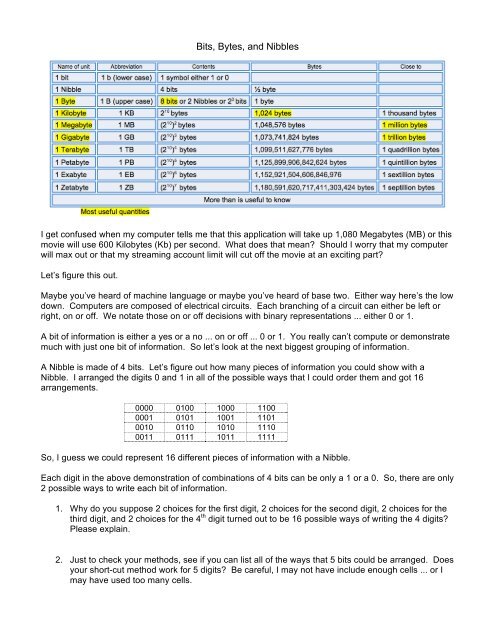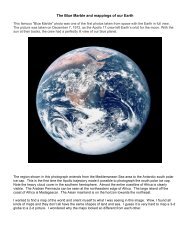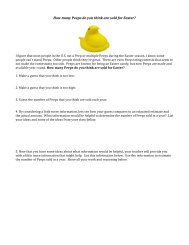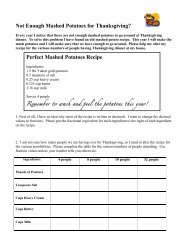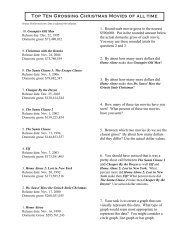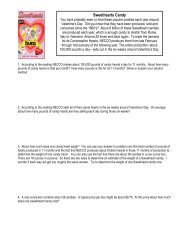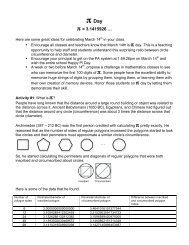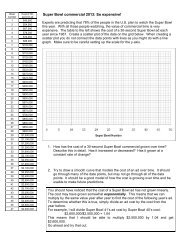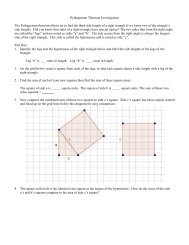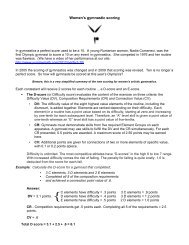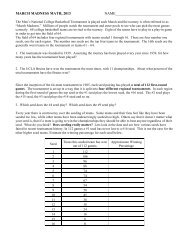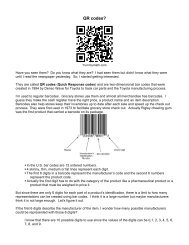Bits, Bytes, and Nibbles - Yummy Math
Bits, Bytes, and Nibbles - Yummy Math
Bits, Bytes, and Nibbles - Yummy Math
You also want an ePaper? Increase the reach of your titles
YUMPU automatically turns print PDFs into web optimized ePapers that Google loves.
<strong>Bits</strong>, <strong>Bytes</strong>, <strong>and</strong> <strong>Nibbles</strong><br />
I get confused when my computer tells me that this application will take up 1,080 Megabytes (MB) or this<br />
movie will use 600 Kilobytes (Kb) per second. What does that mean? Should I worry that my computer<br />
will max out or that my streaming account limit will cut off the movie at an exciting part?<br />
Let’s figure this out.<br />
Maybe you’ve heard of machine language or maybe you’ve heard of base two. Either way here’s the low<br />
down. Computers are composed of electrical circuits. Each branching of a circuit can either be left or<br />
right, on or off. We notate those on or off decisions with binary representations ... either 0 or 1.<br />
A bit of information is either a yes or a no ... on or off ... 0 or 1. You really can’t compute or demonstrate<br />
much with just one bit of information. So let’s look at the next biggest grouping of information.<br />
A Nibble is made of 4 bits. Let’s figure out how many pieces of information you could show with a<br />
Nibble. I arranged the digits 0 <strong>and</strong> 1 in all of the possible ways that I could order them <strong>and</strong> got 16<br />
arrangements.<br />
0000 0100 1000 1100<br />
0001 0101 1001 1101<br />
0010 0110 1010 1110<br />
0011 0111 1011 1111<br />
So, I guess we could represent 16 different pieces of information with a Nibble.<br />
Each digit in the above demonstration of combinations of 4 bits can be only a 1 or a 0. So, there are only<br />
2 possible ways to write each bit of information.<br />
1. Why do you suppose 2 choices for the first digit, 2 choices for the second digit, 2 choices for the<br />
third digit, <strong>and</strong> 2 choices for the 4 th digit turned out to be 16 possible ways of writing the 4 digits?<br />
Please explain.<br />
2. Just to check your methods, see if you can list all of the ways that 5 bits could be arranged. Does<br />
your short-cut method work for 5 digits? Be careful, I may not have include enough cells ... or I<br />
may have used too many cells.
00000 01000<br />
00001 01001<br />
00010 01010<br />
00011 01011<br />
00100 01100<br />
00101 01101<br />
00110 01110<br />
00111 01111<br />
3. Describe an easier way to have figured this out?<br />
4. Without counting any list of numbers, figure out how many different ways you could write a byte of<br />
information.<br />
So when someone wants to send a page of print electronically, they have to use a series of 0s <strong>and</strong> 1s<br />
that represent each of the letters or symbols that they are trying to convey. Each of those letters or<br />
symbols probably contains a byte of information. This could get huge.<br />
ASCII text (American St<strong>and</strong>ard Code for Information Interchange) is binary machine language. The<br />
letters, digits, common symbols, <strong>and</strong> some keystrokes all have binary symbols that are used to print,<br />
calculate, or render text. For instance, a capital “A” in ASCII is 100 0001. So it takes 7 bits to store a<br />
capital “A” in binary. 7 bits is pretty close to a byte. So, it is convenient to think that each character in<br />
English requires a byte for storage.<br />
5. Make a guess about how many bits of memory just one average-length word might require.<br />
Maybe we had better consider a larger grouping of information clusters than just a bit or byte. The next<br />
biggest capacity is a kilobyte (KB). A kilobyte of information contains 1,024 (2 10 bytes of information).<br />
One long paragraph of a typewritten page might contain 1 KB of binary (base 2) information.<br />
6. Take a guess at how large a grouping a digital book might require.<br />
I found that the Complete Works of Shakespeare would require 10MB of storage. That<br />
tomb has about 1,300 pages of print.<br />
7. Choose an average-sized book that you might read, calculate what fraction of<br />
the Complete Works of Shakespeare your book size is, <strong>and</strong> check your guessed<br />
answer to question 6.<br />
Photographs are even denser in file-storage-needs than printed information <strong>and</strong> require much more<br />
memory use. It’s interesting that printed text requires so much less memory than images. One page of<br />
print in an average paperback book might require 2 KB of storage. A low-resolution photograph might<br />
require 100 KB of storage <strong>and</strong> a high-resolution photograph 2 megabytes (MB = (2 10 ) 2 ) of storage.<br />
Uh oh ... a megabyte (MB).
8. Using your calculator, find <strong>and</strong> rewrite (2 10 ) 2 in st<strong>and</strong>ard notation.<br />
9. What power of 10 is the number that you just wrote for problem #7 close to?<br />
Many people use those powers of 10 numbers to approximate how many bytes of information are<br />
contained in a quantity of bytes ... like a gigabyte or terabyte.<br />
My website will only allow me to upload 24 MB of data when I upload instructions for a webpage.<br />
10. What sort of contents <strong>and</strong> how many images might I be able to upload to my site ... printed words,<br />
high-resolution pictures?<br />
Movies <strong>and</strong> music are an entirely different animal. One minute of high-fidelity sound might use 10 MB of<br />
space. So, one minute of sound might require the space of two sets of the Complete Works of<br />
Shakespeare. Doesn’t seem fair.<br />
11. About how long are the songs that you listen to on the radio? How many MB of memory might<br />
one of those songs require? Show your work.<br />
If I filled a pick up truck with books <strong>and</strong> digitized them, they might require 1 gigabyte of memory (GB). A<br />
gigabyte is (2 10 ) 3 bytes of memory.<br />
12. Rewrite (2 10 ) 3 in st<strong>and</strong>ard form.<br />
13. My camera’s memory card holds 1 GB of information <strong>and</strong> photos are denser than printed<br />
information. If one high-resolution picture uses 2 MB, how many high-resolution photographs can<br />
I expect to store on my camera’s memory card?<br />
I have a 6-year old computer with only 2 GB of memory. More up-to-date computers have 4 to 16 GB of<br />
memory. My memory capacity hasn’t yet been a problem for me <strong>and</strong> I program <strong>and</strong> constantly upload for<br />
the <strong>Yummy</strong>math website. Probably my image <strong>and</strong> photo work are the most memory-consuming part of<br />
my work.<br />
But wait, it gets worse ... movies. When you play a DVD on your computer, you might be playing 17 GB<br />
of information. But, luckily that information is stored on the DVD <strong>and</strong> not in your computer. I’d guess a<br />
filmmaker would need an awful lot of memory storage space.<br />
Which makes me wonder about Youtube. I watch quite a few clips on Youtube <strong>and</strong> sometimes include a<br />
clip on our website.
14. Am I quickly using up my computer’s memory? Take a guess <strong>and</strong> explain your reasoning.<br />
Actually, when we posted the movie called the “Three Ships to Locate” about the ingots of silver that<br />
were brought up from the ocean floor, we didn’t upload that much information on our computer, our web<br />
server, or send it to your computer. That movie is housed at Youtube <strong>and</strong> we all just go there to watch it.<br />
Whew.<br />
But how big would a Youtube video be to download to my computer? Youtube movies are usually<br />
recorded at 300 Kb/second. (Notice that the “b” is not capitalized in Kb/second. This is kilobits per<br />
second.) So you might figure out how many seconds the movie that you want on your computer requires<br />
<strong>and</strong> just multiply that number times 300 Kb/second. Then if you divide by 8 (cause there are 8 bits in a<br />
byte) you should get the number of KB of memory that are required for your download. Let’s try that.<br />
15. The “Three Ships to Locate” video was 2 minutes <strong>and</strong> 51 seconds long. About how much<br />
memory does Youtube have to use to store that movie for us to see? Show your work <strong>and</strong> try to<br />
use the most concise units to express your answer ... KB, MB, GB, or TB.<br />
Just so you appreciate what you are using, high-definition video is recorded at about 2,000<br />
Kb/second.<br />
16. Calculate how much memory is required for a 10 minute, high-definition movie.<br />
17. Try to find out how much storage is available on a DVD.<br />
18. I have an iPhone with 6.3 GB of memory. My MacBook has only 2 GB of memory. Should I get a<br />
new computer?<br />
Sources: htp://searchstorage.techtarget.com/definition/How-many-bytes-for#anchor1<br />
http://en.wikipedia.org/wiki/Byte<br />
Brought to you by <strong>Yummy</strong>math.com


